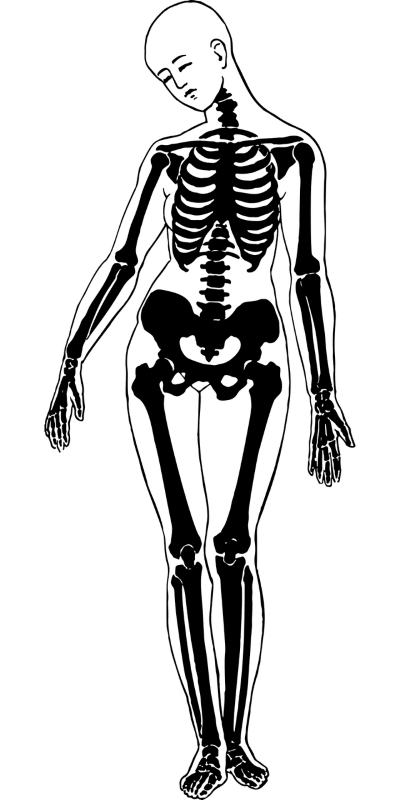 IGCSE BIOLOGY MODEL SOLUTIONS-0610-Extended
IGCSE BIOLOGY MODEL SOLUTIONS-0610-Extended- BY CAMBRIDGE TRAINED EXPERTS
IGCSE Biology Model Solutions are designed to offer you:
1. Free access to completed solved board exam questions from past years.
2. Solutions that provide other accepted alternative answers to the questions.
3. Clear guidelines on answering questios by keeping you well informed of all the answers "not accepted by cambridge"
4. The ability to work without a tutor's help
5. Students my request for the questions to be solved, giving complete reference of ther year and the past paper questions, so that we may be able to offer timely help. Email: [email protected]
Thanks ,
Team ,
Smart Exam Resources.
Also Please do not forget to visit our sites membership area to understand the features of our specially designed paid resources as well.
Please Note: All answers have been typed in blue colour and special hints in red
1.The following is the model solution for may 2019 paper 41 of IGCSE Biology 0610 for Quetsion No: 1, 2 and 3.
1 All commercial breeds of sheep belong to the species Ovis aries.
Species is a group of organisms that can reproduce to produce a fertile offspring
The Merino is a breed of sheep that is farmed mainly for its wool. The wool is very thick and is made of lots of very thin hairs. Fig. 1.1 shows a female Merino sheep with her newborn lamb.
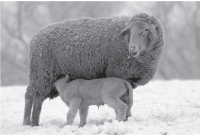
(b) The presence of hair is a feature that is only found in mammals.
State two other features that distinguish mammals from all other vertebrates.
1 .External ears
2 Nipples [2]
Also accepted answers are:Mammary glands/diaphragm/3 bones in the middle ear/sweat glands/enucleated red blood cells/uterus.
(c) Merino sheep in South Africa have high quality wool with very thin hairs. Breeders in New Zealand have used selective breeding programmes to improve the wool of their sheep to match the quality of South African wool.
Describe the steps that breeders would take to breed sheep that have wool with very thin hairs.
The breeders would select the sheep with fine hairs in wool and cross breed them.Then they would measure the hairs in teh wool of all offsprings.They would then select the offsprings with sine hairs in the wool and cross breed them.They would continue the selection and breeding over many generations till they have sheep with very thin hairs.
Please note:In the above answer , instead of cross-breeding, artificial insemination or IVF was also stated to be accepted.
(d) Explain how natural selection differs from selective breeding.
Natural selction differs from selective breeding in the following ways:
2 The rate of photosynthesis of terrestrial plants can be determined by measuring the uptake of carbon dioxide.
(a) Explain why plants take up carbon dioxide during photosynthesis.
Carbon dioxide is, a raw material ( or substrate or reactant ) for photosynthesis. Also the concentration of carbon dioxide is higher outside leaf than inside and hence carbon dioxide diffuses into the leaf. [2]
(b) The rate of photosynthesis of parts of individual leaves can be measured using a hand-held device as shown in Fig. 2.1.
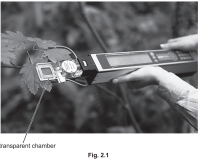
This apparatus allows air to flow through the transparent chamber that encloses part of the leaf. The apparatus measures the carbon dioxide concentration of the air entering and leaving the chamber. Explain how the results from the apparatus can be used to calculate the rate of photosynthesis.
Subtract the concentration of carbon dioxide at the end from the concentration at the start.Then divide it by the time (taken) { or per unit time] . Though we need to know that the carbondioxide levels may vary due to the rate of respiration, as plants respire continuously.
(c) A student used the apparatus shown in Fig. 2.1 to investigate the effect of temperature on the rate of photosynthesis of the leaves of Chinese plantain, Plantago asiatica, at two different concentrations of carbon dioxide, A and B. Fig. 2.2 shows the results of the investigation.
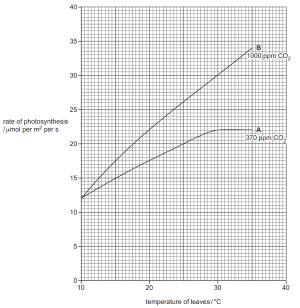
(i) State one environmental factor that should have been kept constant in this investigation.
Light intensity[1]
Other acceptable answers:Water supply or humidity
(ii) Describe the effect of temperature on the rate of photosynthesis when carbon dioxide concentration A was supplied. Use the data from Fig. 2.2 in your answer.
The rate of photosynthesis increases between 100 to 300 and reaches a pleatue at 300. [or levels off/ stays constant]
(iii) Calculate the percentage increase in the rate of photosynthesis at 30 °C when the carbon dioxide concentration was increased from A to B as shown in Fig. 2.2. Show your working and give your answer to the nearest whole number. .
{[30-22]/22} x 100= 36% [2]
(iv) Explain the effect of increasing temperature on the rate of photosynthesis for carbon dioxide concentration B. Use the term limiting factor in your answer. [3]
The temperature is the limiting factor over whole range. When the temperature increases, the kinetic energy / KE, of molecules also increases. This further increases the rate of diffusion of carbon dioxide into the leaf. The temperature also influences [ of affects the activity of) the enzymes. There are now more effective collisions between the substrate molecules and the enzymes in the plant). More enzyme-substrate complexes are formed and more carbon dioxide is fixed [ or used in photosynthesis or converted into sugar. carbon dioxide Thus the concentration is not limiting .
(v) The student concluded that carbon dioxide concentration is the factor limiting the rate of photosynthesis between 30 °C and 35 °C for the results shown for A in Fig. 2.2. State the evidence for this conclusion. B shows that the rate of photosynthesis is higher [ or it continues to increase] , if the carbon dioxide is increased [1]
(d) A similar investigation was carried out on Arizona honeysweet, Tidestromia oblongifolia, that grows in Death Valley in California where the highest temperatures may be greater than 45 °C.
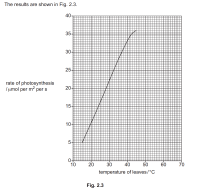 Predict and explain what would happen to the rate of photosynthesis if the investigation is continued at temperatures higher than 45 °C.
Predict and explain what would happen to the rate of photosynthesis if the investigation is continued at temperatures higher than 45 °C.
Prediction:The rate of photosynthesis, remains constant [or decreases or slows because the enzymes [or the active sites] , are denatured at high temperatures. .The stomata close, so, little [or no], carbon dioxide can enter leaves . the plant is adapted to survive at high temperatures
3 (a) Complete the five sentences about the eye and the nervous system.
Structures in the eye change the shape of the lens so that the eye can focus on near and distant objects. This is called accomodation. The radial and circular muscles in the iris of the eye are a pair of antagonistic muscles that work against each other. Muscles in the eye are controlled by the nervous system. The peripheral nervous system contains only sensory and motor neurones. The optic nerve from the eye contains sensory neurones that conduct impulses to the brain .
[5] (b) Transmission of impulses relies on the flow of ions through the cell membranes of neurones down their concentration gradients. Active transport is responsible for maintaining the concentration gradients of ions across the membranes of neurones.
Explain how ions are moved across membranes by active transport.
The movement of ions involves the proteins pumps [ Or / pumps in the neurone membrane. ; Ions such as sodium ions named bind to the protein pumps [ or carriers ] to move the ions against the concentration gradient from a low concentration to a high concentration using energy [3]
(c) Fig. 3.1 shows the junction between two neurones.
Many drugs interfere with the action of neurotransmitters at the junctions between neurones. Two drugs that influence the transmission of impulses between neurones are atropine and eserine. The actions of these drugs are shown in Table 3.1.
Explain the effects of these two drugs on the nervous system using the information in Fig. 3.1 and Table 3.1.
The neurotransmitters move across the synapse [ or gap / junction .The atropine neurotransmitter cannot bind to [ or enter or reach] to the receptors . Therefore no impulses travel along the next postsynaptic,neurone. Hence no impulses reach the CNS .This means there is no sensitivity to stimuli [ or feels no pain ] hence there is no, contraction of muscle [ or no response ]. It acts as a depressant ;The eserine neurotransmitter stays in the synaptic gap . This neurotransmitter can bind to the receptor ,rather than just stay in the synapse. This continuously stimulates the, next [ or the postsynaptic neurone] . A sa result, more impulses are sent in the postsynaptic, neurone..There is a contraction of the muscle [ or there is a response ] Hence it acts as a ; stimulant [6]
(d) A scientific paper was published in 1997 that described the effects of anabolic steroids on female athletes. Many of these athletes achieved great success in international sport competitions during the 1960s and 1970s. Discuss the arguments against the use of anabolic steroids in sport.
[3] [Total: 17]
4 (a) Table 4.1 shows four structures associated with the human male reproductive system. Complete Table 4.1 by identifying the level of organisation of each structure. Choose your answers from the list.
(b) Fig. 4.1 shows the male reproductive system
Table 4.2 shows information about the male reproductive system shown in Fig. 4.1. Complete Table 4.2.
(c) Draw an X on Fig. 4.1 on the structure where meiosis occurs. [1]
(d) Sperm and eggs each have a nucleus which is haploid.
(i) Define the term haploid nucleus. [1]
(ii) State the number of chromosomes in a human haploid nucleus. [1]
[Total: 12]
5 (a) Tissue plasminogen activators (TPAs) are human proteins that are used as drugs to break down blood clots. TPAs break down blood clots by activating plasminogen. Plasminogen is a protein that is always present in the blood. When activated, plasminogen forms a protease that breaks down fibrin molecules.
(i) Plasminogen is found in the plasma. State what is meant by the term plasma. [1]
(ii) State the products of the action of protease on the protein fibrin. [1]
TPAs can be produced by genetically-engineered bacteria. Fig. 5.1 shows some of the stages involved in genetically engineering a bacterium to make a TPA.
(b) (i) State the name of structure A in Fig. 5.1. [1]
(ii) In the flow chart, X represents the action of an enzyme on a molecule of DNA. State the name of this enzyme. [1]
(iii) The TPA gene is inserted into structure A. Explain how the gene is inserted into structure A to form structure B as shown in Fig. 5.1. [3]
(iv) Before TPA was made by genetically-engineered bacteria it was only available from blood donated by people. Suggest one advantage of producing TPA by genetically-engineered bacteria. [1]
(v) The genetically-engineered bacteria produce mRNA that is a copy of the human TPA gene. Explain the role of mRNA in the bacterium. [2] [Total: 10]
6 Fig. 6.1 shows some cells from the shoot tip of an onion, Allium cepa
(a) (i) State the evidence visible in Fig. 6.1 that identifies the cells of A. cepa as plant cells. [1]
(ii) Cell A is dividing by mitosis. State the role of mitosis in a shoot tip. [1]
(b) The area labelled M is a mitochondrion. Explain why mitochondria have an important role in dividing cells. [3]
(c) Cells just behind a shoot tip absorb water and grow in length. A plant hormone stimulates cell elongation and controls the response of stems to gravity.
(i) State the name of the plant hormone that stimulates cell elongation in stems. [1]
(ii) Explain how the response of stems to gravity is controlled. .[4]
[3] [Total: 13]
1.The following is the model solution for October 2019 paper 42 of IGCSE Biology 0610 for Quetsion No: 1
(a) Fig. 1.1 shows four arthropods.
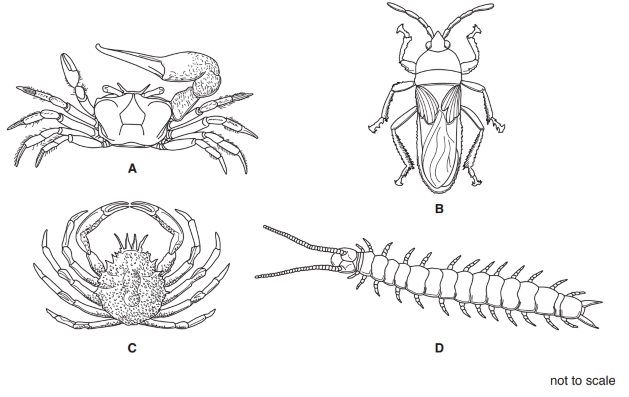
(i) State two features, visible in Fig. 1.1, that are common to all arthropods.
Features of arthropds are:
(ii) Fig. 1.2 is a dichotomous key for the arthropods shown in Fig. 1.1.
Complete Fig. 1.2 by writing suitable statements in: • box 2 to identify species B • box 3 to separate species C and A.
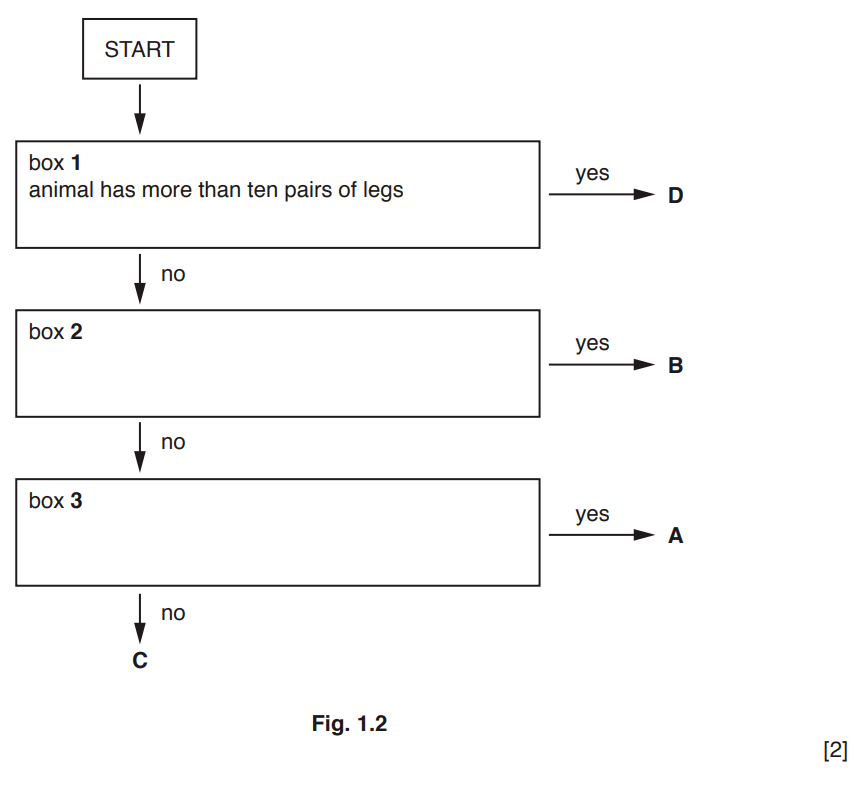
Box 2: any one from:
Box 3: any one from:
(animal has) claws / pincers, of different sizes /
eyes on stalks
smooth, carapace / body / ‘shell’
body, has five sides / is angular
hairs / bristles
Next Previous
Write a public review